Madeleine Laferrière ~ 1847-1912 Fashion designer
Biography of Madeleine Laferrière Fashion Designer
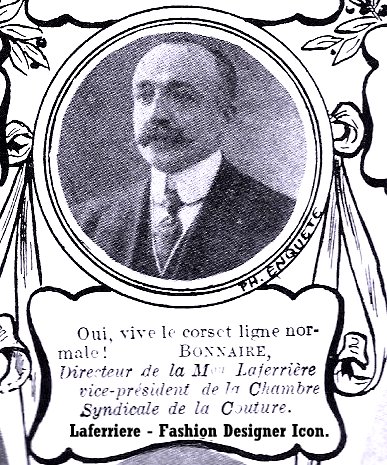 Head Business Manager & Designer
Head Business Manager & Designerwas Arsene Bonnaire. Our research began with finding this rare photograph of Arsene Bonnaire, who was the Director of the Maison of Madeleine Laferrière. This confirms authenticity that he was the Director and the Vice-President de la Chambre Syndicate de la Couture. Read more ↓
Little has been recorded about the Fashion House or Madeleine Laferrière and her rise to fame, although a new light emerges from the overall opinions of the designs, styles, images, and the period, directly from reports by Arsene Bonnaire.
Madame Laferrière, had a very highly regarded Fashion House with quality gowns, which opened in 1869, at the address of 28, rue Taitbout, Paris.
Her establishment was on equal stature to the fashion houses of Doucet and Paquin, and it could be said indeed of Worth. So we wonder why so little is known about her biography. Should we all get hunting for the elusive Laferrière story?
The House of Laferriere designed for Royalty – Queen Maud of Norway was besotted with her dresses and had a large number of the most elaborate evening styles for her wardrobe. She was the youngest child of Princess Alexandra and the Granddaughter of Queen Victoria.
She was born in 1869 and Married in 1896 to Prince Carl of Denmark.
Other Royal Client’s included Princess Matild and the Empress Eugine.
1907 – A magnificent deep purple gown shown on the front cover of La Mode Illustree, is described as Toilette de visites, by Laferrière
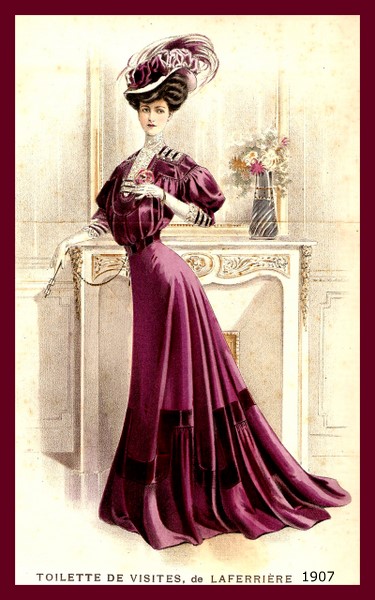 La Mode Illustree 1907 Purple Elegance
La Mode Illustree 1907 Purple EleganceMany Actresses for the Paris Theatre were important Client’s and the designs were of lace lavishly embroidered with beads, sequins and diamante, to stand out on the stage. Long draped skirts to the gowns flowed into trains. Completing the outfits were long evening wraps.
1907- Silver grey to dark grey with elaborate stitching and finishing makes this a gown of exceptional quality. The description given is, Robe en Satins et Liberty et Gaze, by Laferrière. This design was displayed on the front cover of La Mode Illustree.
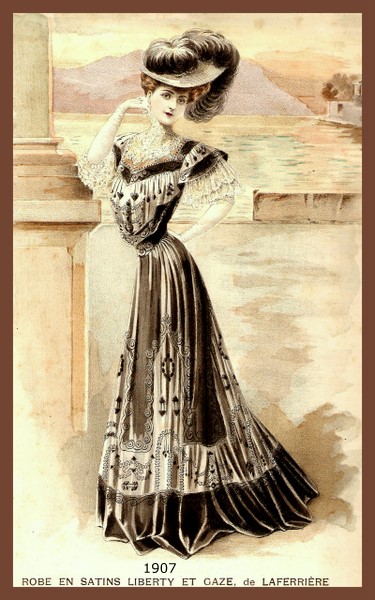 1907 Silver grey with dark grey bands
1907 Silver grey with dark grey bands1907 – A rare backdrop painted in Tropical Gardens, which may have been part of an exhibition of exotic plants and flowers. A very special white gown of lavish detail. The train at the back is laiden with pink roses. The Lady is carrying a fan so the temperature was high in this unusual setting.
The description is, Robe de Reunion en Tulle blanc, by Laferrière. The image is from La Mode Illustree, Paris, and is a front cover feature.
 July 1907 – Reunions
July 1907 – Reunions1907 – Toilet en Mousseline Blanche by Laferriere.
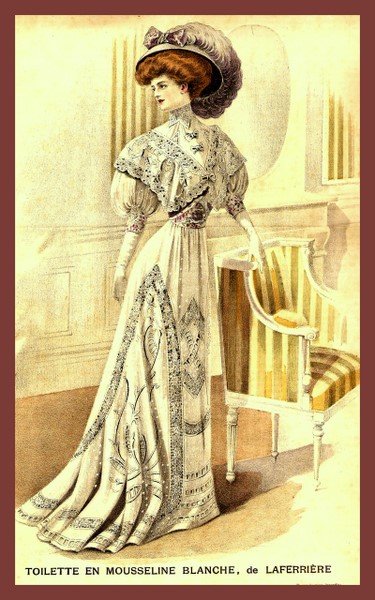 September 1907 La Mode Illustree
September 1907 La Mode Illustree1907 – Sheer perfection for attention when walking. This very pretty gown with an impressive hat is described simply as, Toillet d’Etre, by Laferrière. Another front cover La Mode Illustree in our collection.
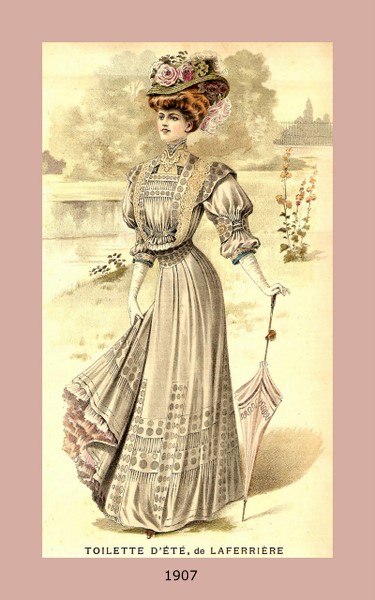
Arsene Bonnaire’s first wife was called Josephine and they had one daughter named Suzanne. His second wife was Jane Atches this was her maiden name and she was married before to Raymond Leroux. Her dates are 1872- 1937. They were married on 20th April 1920. Her life until quite recently was undocumented and she was an incredable Artist in the style of Art Nouveau during 1895-1912.
FOUR RARE DESIGN ARCHIVE PHOTOGRAPHS. 1907 – 103 Years old!
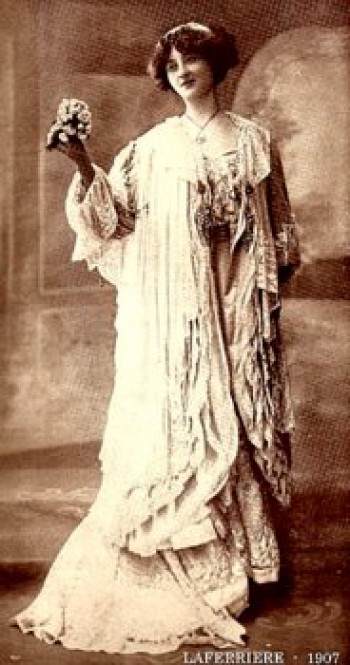

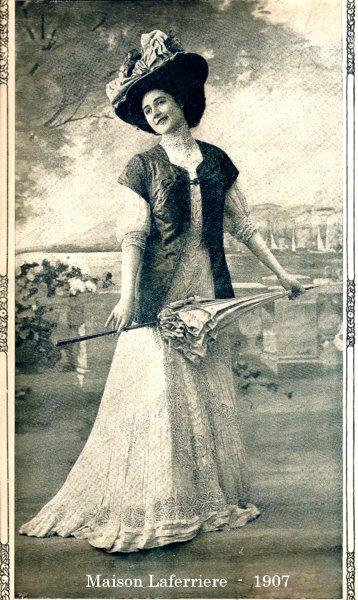
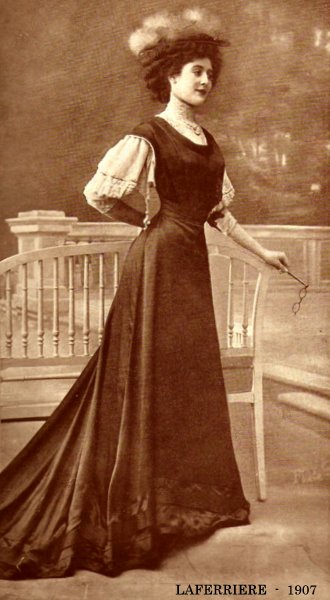
More news about Asene Bonnaire – Archive research from America
An archive written by him which was extremely enlightening as to his intellectual expertise on the subject and probably the answer to the age old question on “Why and where does the French elite unmistakeable elegance of simplicity within design come from, and why it is so unique in the history of Couture”. Also renowned throughout the world in its dominance.
Reported in 1912 this fashion article reads:- Arsene Bonnaire, Director of the Maison Laferrière, says “the French and American women have the same idea of Silhouette”.
Does the taste of the American woman differ from that of the Frenchwoman? “I think not. The American woman of all women most closely approaches the French woman in taste. What apeals to the Parisienne appeals also to the American in a manner stronger and more exact, if I may use the word, than to women of other nations”.
“One reason is that there is a greater similarity between the figure of the women of these two countries than between the French and any other nation. They have the same ideal of the silhouette, elegant, svelte, neither too thin nor too stout. The gowns of the one are therefore well adapted to set off the beauty of the other. In the matter of detail their tastes are similar.
This opinion of mine that the American taste closely resembles the French does not seem to me open to discussion. Indeed, I do not feel merely that I express an opinion, I DO MORE – I STATE FACT”.
Surely it is proved by the circumstances that American women who can afford it buy gowns in Paris and pay the ENORMOUS DUTY required to get them into their country. Still further it is proved by the fact that the houses which rival us must always find their inspiration in PARIS.
The Dressmakers who cater to the taste of fashionable women in America come to Paris to find the atmosphere they need in order that their ideas may ripen.
The large department stores send Buyers to acquire models from us and to COPY them. WHY? Because the American woman resembles the Frenchwoman in her tastes.
Can there be any other explanation? Perhaps here you will say that if the American taste resembles the French taste, it can still develop alone.
As one has done so the other may do, you will say, and America is a large country, full of artistic talent, full of wealth, full of ambition.
Undoubedly, but it will NOT BE IN OUR DAY, nor in our grandchildren’s day. In saying this I do not underestimate the American genius, which I deeply admire.
The reason why the American will continue to draw inspiration from Paris in the matter of artistic dress is deeply founded on conditions which CANNOT BE CHANGED.
Consider a moment on what our taste is based. Coral insects build their islands hardly more quickly than taste is formed, or at least that national taste which makes the greatness of the Paris Dressmaker. For the individual can do little. There must always be in addition the ATMOSPHERE in which he can grow.
Our Haute Couture thrives in Paris because it has an atmosphere of appreciation, of criticism and of inspiration. This atmosphere is as essential as light and air to a growing plant.
One cannot have great Composers where music is not in the hearts of the people, and while the professions of Haute Couture may not be as great an ART as Music, it is at least an ART like it. It cannot become suddenly perfect, out of an unsympathetic environment.
This atmosphere grows slowly. To reach perfection it requires generations, and our ART of Dressmaking has been forming in France for 300 years. One cannot lightly value such a development and American women even when they do not think out the reason, readily grasp the fact that here, as nowhere else, is what we may call PERFECTION TO DETAIL.
Here Bonnaire explains in detail the Paris Fashion industry inspirations and its evolving greatness. He says “when Dressmakers are away from Paris they miss the atmosphere, the ELECTRIC CURRENT we may call it, that exists ONLY IN PARIS”.
Indeed, with the years, the American can in matters of taste come only closer and closer to her French Sister!
(How right he was nearly 100 years ago).
Written in 1912! It’s difficult to imagine when he talks about 300 years of history of the Fashion Industry, it’s now nearly 400 years.
Three unusual colour fashion plates all found from La Mode Illustree dated 1912.
1912 – Purple Satin Suit for the Village Garden visit. A really smart ensemble with the traditional large hat of the era.
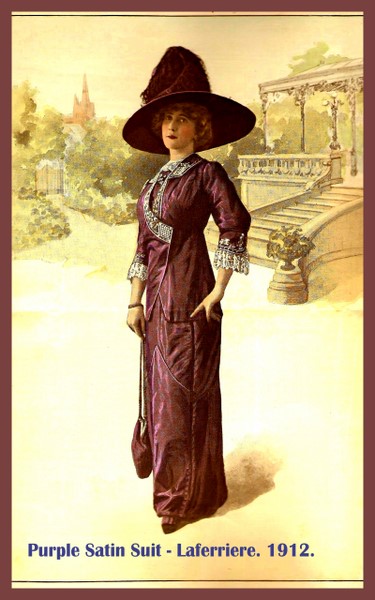
1912 – Vivid Orange for the visit to the Aeroport showing an aeroplane flying in the sky an unusual rare backdrop for this magnificent Laferrière gown. The sky’s the Limit!

1912 – Olive dark green Velvet for the visit to the village park to hear the latest music!
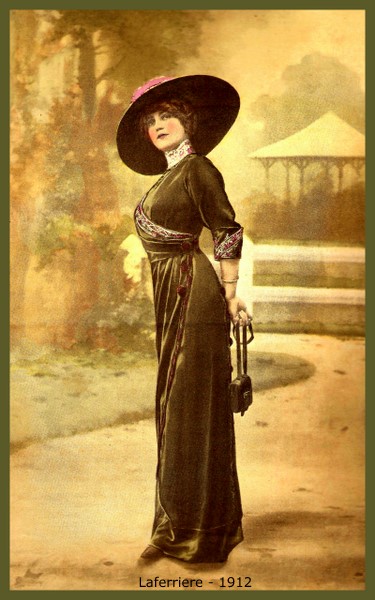
Latest updates August 2012 Two rare Laferriere suits
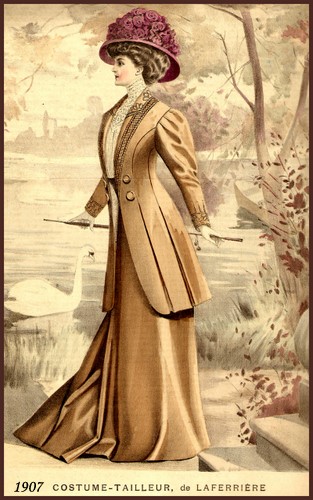
Laferriere - 1907 walking suit
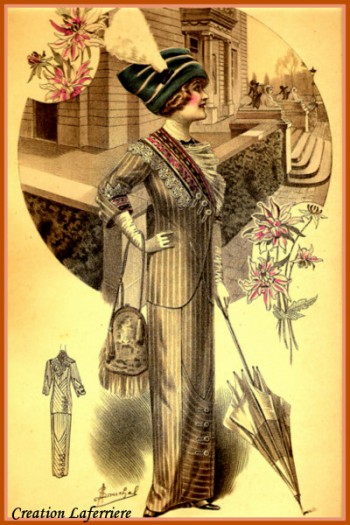
Elegant straight long suit
Artist: A. Souchal – La Femme Chic Pour l’apres midi. Undated, but likely 1912.
After Madame Laferrière died (1912), we do not know who continued, as we know little of her life or if Bonnaire carried on here but it is recorded that some time before 1923 Arsene Bonnaire retired from the scene.
It seems that Arsene Bonnaire was an extremely big influence in the Fashion House of Mme Laferriere and now largely forgotten. We hope this brings together some interesting facts.



